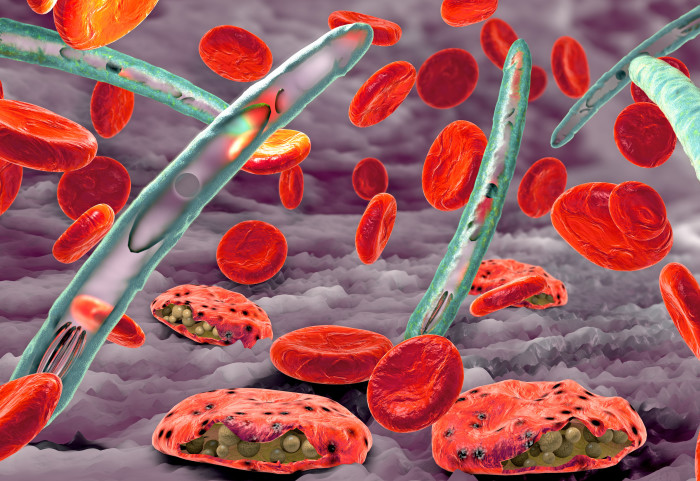

Some malaria parasites have genetic variants that allow them to infect those with sickle haemoglobin, which had been thought to give protection.
For the first time, malaria genetic variants have been discovered to associate with the human sickle haemoglobin gene, suggesting these parasites may have adapted to overcome the protection offered by this well-known red blood cell human mutation.
The new research, from the Wellcome Sanger Institute, the University of Oxford, Imperial College and the MRC Unit The Gambia, along with collaborators from the KEMRI-Wellcome Trust Research Programme Kenya, the U.S. and Mali, suggests that this group of malaria parasites may have evolved to be able to infect and cause serious disease in those who carry sickle haemoglobin. Further research is needed to understand the biological mechanisms behind this.
This study highlights the importance of continually investigating this parasite so that we can be informed about how it adapts against selective pressures Professor Tom Williams
The study, published today (9 December 2021) in Nature, identified three genetic variants in the parasite genome that are found unusually often in infections of individuals who carry at least one copy of the sickle haemoglobin gene, showing correlation between the two. Sickle haemoglobin, which causes sickle-cell anaemia when inherited in two copies, is commonly found in individuals from sub-Saharan Africa because one copy provides protection against malaria.
From this study, further research into the biological function of these parasite variants and the mechanisms by which they interact with sickle haemoglobin can be investigated. Understanding these key questions could lead to new ways to protect against and treat malaria.
Malaria is one of the world’s most deadly infectious diseases, with an estimated 229 million cases and over 400,000 deaths in 2019, most of which were young children in sub-Saharan Africa. In this region, the disease is mainly caused by the parasite, P. falciparum, which has been shown to have different genetic profiles depending on which area it is found in. Tracking these parasite populations gives insight into how different groups of malaria parasites compete for survival and spread, and can help inform control measures.
In this new study, researchers sequenced the parasite genomes from over 3,000 infections in children from The Gambia and Kenya, all of whom had severe symptoms of malaria, and compared their host and parasite genomes.
They found that infections of individuals with sickle haemoglobin tend to be caused by a certain type of parasite. Specifically, they tend to have particular mutations in three regions of the parasite genome, all of them appearing in genes whose function is currently unknown.
Professor Tom Williams, Chair in Haemoglobinopathy Research in the Department of Surgery and Cancer at Imperial College and Wellcome Trust Senior Fellow at The Kenyan Medical Research Institute (KEMRI), who co-authored the research, said: “Malaria is a deadly disease, taking hundreds of thousands of lives every year. Previously, sickle haemoglobin was believed to have a protective effect against severe disease. However, this study highlights the importance of continually investigating this parasite so that we can be informed about how it adapts against selective pressures.”
The researchers suggest that sickle haemoglobin in humans may have acted as a selective pressure on the parasite, driving it to adapt and leading to a population that can now infect people with sickle haemoglobin as well as those with normal haemoglobin. However, these sickle-associated parasites are not fully dominant across the African continent even though they seem to be able to infect the majority of humans compared to other strains, implying there may also be other factors impacting spread.
While this research implies that sickle haemoglobin in humans plays a role in shaping parasite genomes, further research is needed in larger populations and in those that are asymptomatic to shed light on the genetic interaction between the parasites and host genome.
Band, et al. (2021) Malaria protection due to sickle haemoglobin depends on parasite genotype. Nature. DOI: 10.1038/s41586-021-04288-3
Article text (excluding photos or graphics) © Imperial College London.
Photos and graphics subject to third party copyright used with permission or © Imperial College London.
Reporter

Benjie Coleman
Department of Surgery & Cancer

Contact details
Tel: +44 (0)20 7594 0964
Email: b.coleman@imperial.ac.uk
Show all stories by this author


